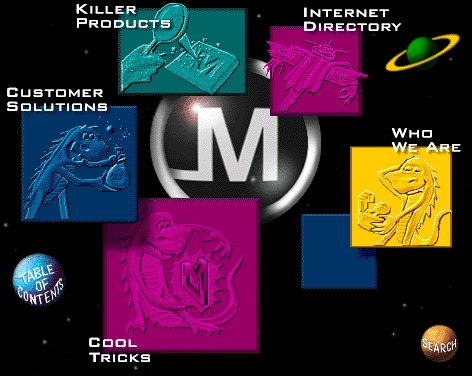I've been collecting all kinds of cyberjunk for years. Old Microsoft Developer T-shirts, Flooz handerchiefs, pre-AOL Time-Warner frisbees, and yes, pictures of old dead web sites. I also collect old railroad timetables and match book covers - maybe there's a connection there somewhere.
So I'm a pack rat - on the Web and in RL - and I know I'm not alone. In fact, pack rats are probably less interesting and less numerous creatures than
Jackdaws, which steal, horde, and festoon their nests with any shiny bright bauble they fly over during their work day. Neither Charles Darwin nor anybody else has figured out why these strange birds collect the shiny effluvia left behind by human beings: they just do it, and perhaps their behavior furthers their attempt to gain a long-term foothold in evolution's spiral that we'll never completely understand.
Perhaps you're a digital jackdaw too. Perhaps there's a part of you that will really never get over the first hallucinogenic moment - perhaps in 1993 or '94, perhaps last week, when you saw the Web for the first time. In the same way that drug addicts will spend their life savings trying to recapture that first mad moment of ecstacy, people deeply impressed by their first exposure to the World Wide Web frequently return to it, or perhaps it returns to them. Either way, the Web provides constant reminders of its past - and a vortex back into time, when we were all younger, richer, fresher, and life at 56K was the norm.
Nostalgic sounding, doesn't it? Web Nostalgia isn't really big right now - the last 10 years are still with us - some would say "all too much with us". But it will come, in the same way that Saturday Night Fever keeps coming back, or scooters, skateboards, yo-yo's, and mindless rhythmic music. At the risk of sounding like a latter-day Joe Franklin (the "world's number one collectible of memorabilia"), it's all too likely that the Web soon take its place in the pantheon of lost fads, and perhaps that's where it belongs, right next to one's old 386SX notebook, an Apple IIe, and one's never used Radio Shack CB Radio.
But wait a minute - wasn't the Web - yes, this thing that somehow is bringing you the thing that you are now reading - going to be a lot more than simply a fad that would come, go, and expire as soon as something better more interesting came along? Didn't the Web represent a quantum leap for humanity, in terms of realizing the global "noosphere" predicted by visionaries such as Tielhard De Chardin? If so - if there was and is something culturally unique going on here that is the very beginning of what is a much longer-term trend - are we not obligated to treat it with a bit more respect than yesterday's garbage?
This isn't just idle "jackdaw-level" curiosity at all the bright shiny baubles we've created in the last 10 years. The very idea of studying Web History (as opposed to Net History or Computer History) supposes that there was and is something unique on the Web - especially in terms of how it synergetically combines text, image, speech, and anciallary forms in a special "sensory web" that makes it more than simply "all that there stuff that uses the Hypertext Transport Protocol), And yet the sad truth is that most of the Web - perhaps 99% of its terrabytes of information - is cybergarbage whose evanescence is probably well-deserved. The problem, of course, is deciding which part gets preserved and which thrown out. Who controls history? Well - we do - at least until the historical record disappears (Note: the average life of a Web page is a mere 44 days).
One thing we - historians, amateur ones like myself and profession ones inside the academy - can say is that the Web is a creature with a big brain but no memory facilities. In fact, one could almost call it brain-damaged in terms of its inability to retain much of its own past. Dystopians term it an Orwellian medium that doesn't even need a poor sot like Winston Smith to rewrite the files maintained at the Ministry of Truth - the Web deletes itself, through a complex web of interactions - some technological, others purely social - all of which conspire to make it an ephemeral, malleable, and impermanent.communications channel - more like the telephone than the telegraph.
Why study Web History? Well - because it's really damned strange, when you really start to sort though the digital dumpster. And once in awhile, one can find a discarded pearl or two of wisdom there. But more importantly, as computer-mediated information grows (in 2002, human beings created about 800 megabytes each), it's clear that nobody - outside a handful of institutions that each have their own approach to the problem - is making the connection between our digital past and our digital future.
What was the Web Generation up to in its first 10 years? What did they build here? Was it good? Was it bad? Was it blind? Was it stupid? Could it hold a key to what's next? Is it simply rubbish that's as dead as yesterday's news? Or do all of these questions pale when compared to the ultimate question - did Karl Marx's prediction that humanity will reach "The End of History" actually refer not to a triumph of socialism, but to our arrival at a cliff heralding a new, possibly digital Dark Age, wherein history will actually disappear in some undreamt of meta-systemic-crash, like an "info-stroke"? Is History Itself "Obsolete"? That's the "ah-hah" question that lurks - like a ghoul - at the end of any extended meditation upon this subject.
Web Historians are not futurists, but anti-futurists who reason that our strange, jackdaw-like behavior and our habit of looking backward, not forward, is no more dangerous than focussing exclusively on the road ahead. Studying the past through the Web presents a view that cuts against the grain of the future-bias of this medium, which always and forever will be focussed on the Now and the Next (as it was designed to do). Many of us reject the notion that a central canonical "Web History" can ever be written, or that it even
should be written. That perhaps a decentralized set of "histories" might more accurately describe the actual zeitgeist of digital culture, even if they suffer from an alarming lack of comprehension.
What unites us is that there is something about the notion of all this impermenance that deeply disturbs us. Perhaps we see that the New Library of Alexandria is being made not of marble, but of straw. Perhaps we're just a bunch of jackdaws whose Quixote-like quest to capture and preserve artifacts from early digital culture is ultimately pointless. Maybe we're just stick-in-the muds suffering from a kind of nauseating motion sickness that Internet Time induces over long periods of exposure. Or brave "Necronauts", as Bruce Sterling puts it, who just dig banging around in abandoned industrial sites. We ourselves do not always know who we are. But these and other considerations go a long way to answer the question: "Why Study Web History at All?"
Labels: Pre-Google Internet, Time Inc., Web History
 I've been publishing Ghost Sites of the Web since the Summer of 1996, and it's been a great ride. But as live forces its changes upon us, we must adapt. This year, I've gone through two tragedies that have completely altered my life. Both my beloved mother and sister committed suicide earlier this year. I will probably spend the rest of my life trying to understand how this could happen, faulting myself for failing to prevent it. One can only try to move through such an experience on a day by day basis, and try to keep moving, because depression, it's said, "has a hard time hitting a moving target."
I've been publishing Ghost Sites of the Web since the Summer of 1996, and it's been a great ride. But as live forces its changes upon us, we must adapt. This year, I've gone through two tragedies that have completely altered my life. Both my beloved mother and sister committed suicide earlier this year. I will probably spend the rest of my life trying to understand how this could happen, faulting myself for failing to prevent it. One can only try to move through such an experience on a day by day basis, and try to keep moving, because depression, it's said, "has a hard time hitting a moving target."










